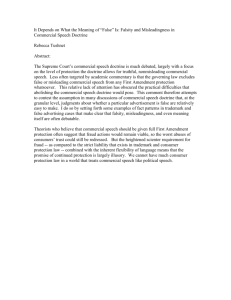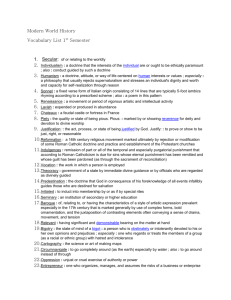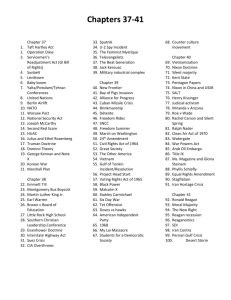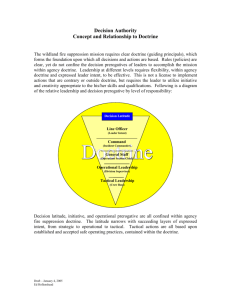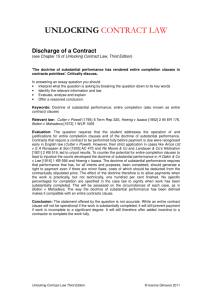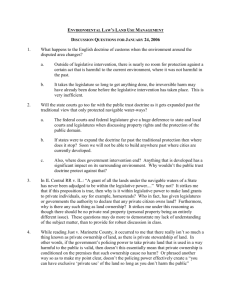Essential Facilities Doctrine: A Case for India
advertisement
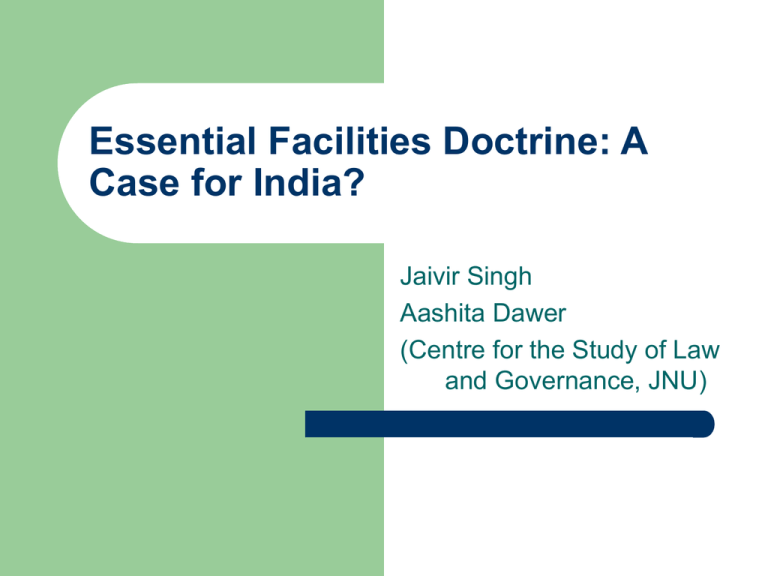
Essential Facilities Doctrine: A Case for India? Jaivir Singh Aashita Dawer (Centre for the Study of Law and Governance, JNU) Essential Facilities Doctrine Dominant/monopolistic firm’s refusal to grant access to a facility it controls, which is necessary for competition and infeasible to replicate, can give rise to a legal antitrust/antimonopoly liability. Clearly it counters the proprietary right of producers to design their platforms & exclude others. Doctrine is defined (has meaning) only over network goods. Network Goods Network Externalities - value to the buyer of an extra unit of the good increases as more units of the good are sold. Apparently upward sloping demand curve Composite and complementary nature of the goods makes the compatibility across a network a crucial constituent Degree of compatibility is decided strategically by firms, tipping towards ‘winner takes most’ outcomes. Follows naturally from nature of network goods, not necessarily on a/c of anticompetitive behaviour. In welfare terms compatibility creates maximum CS & equality. This is not achieved by free entry – rather by compatibility of the network platform. Therefore an antitrust doctrine that counters proprietary rights. Development of the Essential Facilities Doctrine Chequered History in US – Supreme Court: Terminal Railroad (1912), Associated Press (1945), Otter Trail (1973). Seventh Circuit Court MCI (1983) MCI (interconnect between AT&T and competitor) puts out the test: For the doctrine to kick in it must be shown that 1) a monopolist controls an essential facility 2) the facility cannot be reasonably duplicated 3) the monopolist has denied access 4) it was feasible for the monopolist to share the facility. Development of the Essential Facilities Doctrine (contd.) Problems: a) Aspen Skiing (1985), b) Academic attack - Areeda famously states that the Essential Facilities Doctrine is less a doctrine than an epithet “indicating some acceptation to the right to keep one’s creations to oneself, but not telling us what these acceptations are”, c) Inspired by such speak, American Supreme Court ruling in Trinko (2004) case stating that non-compliance with the Telecom Act was not a valid basis for antitrust liability and that the defendant did not have a general duty to deal with rivals with whom it had not dealt before. Dicta but said that the Supreme Court does not recognize the doctrine. To be noted though, In the final settlement worked out under the supervision of the courts, Microsoft was required to licence interoperability information to producers of non Microsoft servers – this was clearly a reasoned move to encourage ‘open access’ with the hope that it would encourage continuing innovation. Development of the Essential Facilities Doctrine (contd.) Solution (Academic - Frischmann and Waller 2008-2009, A.L.Jr.) Like IP law, it is a question of balance between the ‘open’ and exclusion. Traditional doctrinal test evaluates market conditions of an upstream resource in the manufacture of a commodity and asks whether competitive supply is possible. Instead if ‘Essentiality’ were approached from the ‘demand’ side the doctrine ends up gaining a lot more substance. Circumstances favouring the open for infrastructure – precisely because value of input from infrastructure into final goods is cannot be measured. Social benefits derived from the downstream uses of transport, electricity, basic research (ideas), environmental ecosystems, and the internet is best kept in a state of open access as is possible. India and the Essential Facilities Doctrine: Q how to think in relation to the Indian jurisdiction. Sufficient possibilities of being incorporated by the Competition Act. Section 3(4)(d) of the Act ‘refusal to deal’ to be an anti-competitive practice i.e. refusal to form agreement of sharing a facility necessary for buying and selling of Section 4(c) asserts that denial of market access to others by a dominant player would be an abuse of dominant position held by him. Section 18 and 19, Commission can abolish practices that have adverse effect on competition. Specifically, section 19(3) and 19(4) deal with determining factors that restrict emergence of competition viz. creation of barriers to new entrants, driving existing competitors out of market, etc. and ascertain the dominant position through market share of the firm, size and importance of competitors, etc. respectively. Indian Regulatory Acts incorporate elements of the ‘Essential Facilities’ idea. TRAI, Electricity and Gas Regulations carry provisions with the executive branch being empowered to decree sharing. How to think of EF in the Indian Context? (contd.) Given this regulatory presence, question is whether there is scope for hierarchy of Competition Act over Regulatory law – regulatory Law is typically specific but it would be good to have a law that is general enough to incorporate a variety of contexts, including the unregulated world of infrastructural inputs.

